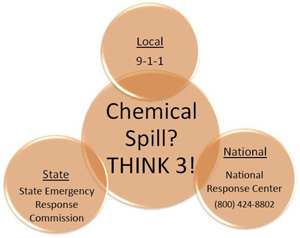Chemical Risk Programs
EPA‘s Chemical Risk Information Programs provide citizens with information and valuable resources to help better understand what chemicals are in our communities and the potential risks associated with those chemicals. EPA also provides support and resources for regulating agencies at the state, county, tribal, and local levels. All information and resources that we provide are accessible to any interested parties.
For Region 7 businesses, EPA has provided up-to-date regulated chemical lists, hazardous substance regulations and reporting requirements, along with fact sheets, spill reporting requirements, and other resources. Reporting requirements can often be complex, so it is important to remember that we are always available to assist businesses in managing risk.
National Information
- NATIONAL RESPONSE CENTER:
(800) 424-8802 - EPA’S EPCRA/CERCLA HOTLINE:
(800) 424-9346
Emergency Contacts
- EPA REGION 7 SPILL REPORTING:
(913) 281-0991 - State Office Contacts
 |
In Your Community |
 |
Businesses |
 |
SERCs/LEPCs/TERCs |
 |
About Us |

Chemicals in Your Community Informational Pamphlet (PDF) (24 pp, 1.53MB, About PDF)
Want to Know What’s in Your Community?
Companies must report when a certain amount of regulated hazardous substances are present in their facility or have been released to the environment. Try these great online tools to see what facilities in your area report manufacturing, using, or storing hazardous substances and what hazardous substances they’re reporting:
- Envirofacts
- TRI.NET
- The Right-To-Know Network
- Scorecard: The Pollution Information Site
- National Response Center
Want to Report a Spill or Environmental Violation? (And other resources for concerned citizens)

EPA Region 7 Spill Reporting Numbers and Links
- Iowa Chemical Spill Reporting (PDF) (2 pp., 227K, About PDF)
- Kansas Chemical Spill Reporting (PDF) (2 pp., 229K, About PDF)
- Missouri Chemical Spill Reporting (PDF) (2 pp., 225K, About PDF)
- Nebraska Chemical Spill Reporting (PDF) (2 pp., 251K, About PDF)
Which Regulations Affect You?
If you manufacture, use, or store the threshold quantity of hazardous or extremely hazardous substances listed in the following regulations, you may have obligations including reporting, risk management, hazard assessment, employee training, process safety, and more. Follow these links to review the hazardous and extremely hazardous substances covered under each regulation and their respective threshold quantities (and to determine whether your facility is a regulated one):
- Comprehensive Environmental Response, Compensation, and Liability Act (CERCLA) (PDF) (46 pp, 278K, About PDF)
- Emergency Planning and Community Right-To-Know Act (EPCRA)
- Clean Air Act Section 112(r)
- Comprehensive List of Lists (combines all three regulations into one list)
CERCLA: (Resources for facilities which must adhere to CERCLA requirements)
- Release Reporting for Non-Continuous Releases
- Release Reporting for Continuous Releases
- CERCLA/EPCRA Release Reporting Flowchart (PDF) (1 pg, 62K, About PDF)
- Fact Sheet: General Release (Spill) Reporting Requirements
- Rule Change Provides Exemptions from Reporting Requirements for Air Releases of Hazardous Substances from Farm Animal Waste Fact Sheet
EPCRA: (Resources for facilities which must adhere to EPCRA requirements)
- Emergency Planning Requirements (EPCRA Section 302)
- Chemical Spill Reporting (EPCRA Section 304)
- Chemical Inventory Reporting Requirements (EPCRA Sections 311-312)
- Toxics Release Inventory (TRI) Reporting Requirements (EPCRA Section 313)
Clean Air Act Section 112(r): (Resources for facilities that must adhere to Clean Air Act (CAA) Section 112(r) requirements)
- General Duty Clause
- Risk Management Programs/Plans
- Risk Management Plan (RMP) Electronic Tools
- Preparing for an EPA RMP Inspection Fact Sheet
- RMP Audit/Inspection Checklist for Program 1 and Program 2 Facilities (PDF) (13 pp, 110K, About PDF)
- RMP Audit/Inspection Checklist for Program 3 Facilities (PDF) (22 pp, 283K, About PDF)
- RMP*eSubmit
- Risk Management Program Presentations for Ethanol Industry
Are You an Ethanol Plant Owner/Operator? Click Here (PDF) (104 pp, 2.94MB, About PDF)
Are You an Anhydrous Ammonia Refrigeration System Operator? Click Here (PDF) (80 pp, 1.56MB, About PDF)

NRT Hazardous Materials Emergency Planning Guides ![]()
Chemical Emergency Planning and Preparedness eTools
Contingency Planning Resources
RMPs Are on the Way! (PDF) (63 pp., 1.31MB, About PDF)
Energize Your Local Emergency Planning Committee (PDF) (12 pp, 542K, About PDF)

Why do we do what we do?
Chemicals are an important part of the modern world. They provide fuel for our cars, kill pests on crops, and make our water safe to drink. We can find them in our homes, our schools, and even the food we eat. Unfortunately, much of what makes these chemicals so valuable to us can also make them very dangerous. If these chemicals are not used and disposed of properly, they can be a threat to human health and the environment. Disasters such as the BP Texas City Refinery Explosion (2005) and the tragedy at Bhopal, India (1984), remind us why EPA must continue its mission to protect human health and the environment. The Chemical Risk Information Programs are dedicated to protecting our health, the health of our children, and the health of the environment in which we all live and work.
History of EPA
Three-minute summary of the Emergency Planning and Community Right-To-Know Act (EPCRA) ![]()
EPA Image Gallery
EPA Incident Investigations
- BPS, Inc – West Helena, Arkansas (PDF) (83 pp,7.4MB, About PDF)
- Accra Pac Group, Inc. North Plant – Elkhart, Indiana (PDF) (55 pp, 11MB, About PDF)
- Prevention of Reactive Chemical Explosions – Case Study: Waste Fuel/Oxidizer Reaction Hazards (PDF) (6 pp, 143K, About PDF)
- Other EPA Incident Investigations
Region 7 Incident Investigations
- Terra Nitrogen – Port Neal, Iowa (PDF) (114 pp, 2.9MB, About PDF)
- Expert Review of Terra Nitrogen – Port Neal, Iowa (PDF) (115 pp, 31MB, About PDF)
- ChemCentral – Kansas City, Missouri (PDF) (83 pp, 12.71MB, About PDF)
Chemical Safety Board Incident Investigations
- Anatomy of a Disaster (The BP Texas City Refinery explosion)
- Herrig Brothers Farm Propane Tank Explosion
- DPC Enterprises Chlorine Release
- Praxair – St. Louis, Missouri (PDF) (10 pp, 371K, About PDF)
- Other Videos from Chemical Safety Board
|
|
![[logo] US EPA](https://swap.stanford.edu/was/20170911010949im_/http://www.epa.gov/epafiles/images/logo_epaseal.gif)
